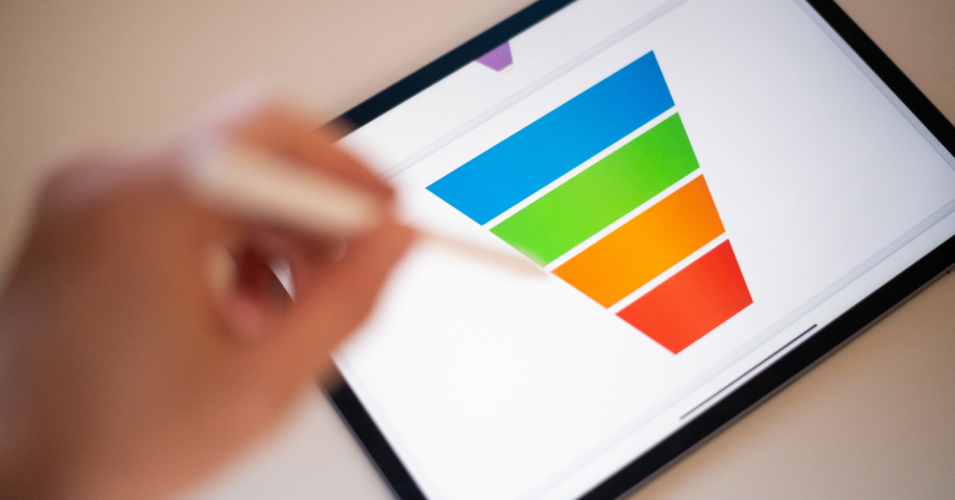The goal of any marketing effort is to convert a prospective customer into a lead. Therefore, your brand needs to be strategic in its marketing approach to avoid overwhelming customers in the early stages of the buyer funnel (as this can prevent progression and conversion). We recommend a full-funnel approach to build brand loyalty and longevity. Utilizing only bottom-of-funnel tactics may result in early wins, but it loses its efficiency and ability to convert over time.
Here, we will explore the top, middle, and bottom of the buyer funnel and how these stages correspond with the customer journey. We will also discuss how the messaging and approach should differ as you move down the funnel.
Breaking Down the Marketing Funnel and the Buyer’s Journey
Understanding the path a potential customer will take is essential in creating the right marketing funnel. Before we can understand the full funnel, it’s important to break down each stage of the customer’s journey.
The Awareness Stage – Top of Funnel (TOF)
This is the researching stage where the buyer has a problem or a need but is not yet considering any provider to offer the solution. They may lack a complete understanding of their pain point and could be looking for more information to understand it further.
A typical question could be, “Why am I losing my ranking on Google?” These initial problems, needs, questions, and concerns will drive the prospective customer to the second stage of the buyer’s journey.
The Consideration Stage – Middle of Funnel (MOF)
Here is the evaluation stage, where the buyer understands the problem and is looking for various solutions. They are not ready to buy (yet) but are looking at the advantages and disadvantages and comparing prices of various providers.
Buyers may ask or search for “SEO companies in New York City.” They will then read about their services, prices, and any other relevant information.
The Decision Stage – Bottom of Funnel
Buyers at this stage have sufficiently explored the available options and are interested in purchasing a given service or product.
Since buyers want to make informed choices about their purchase, at this stage they’ll watch videos, check reviews, and read testimonials to be certain before investing. Through these final processes, customers are trying to understand why they should do business with a particular company and not others.
Understanding the Marketing Funnel in Paid Advertising
Top of Funnel
TOF in paid advertising can mean two things. First, it involves campaigns made to warm unfamiliar audiences about the brand and its business. At this stage, you are non-disruptive and don’t ask too much from the audience.
Several types of TOF campaigns include:
- Awareness – Lets people know of your brand, business, or services.
- Reach – Reach as many users as possible within the target audience.
- Post engagement – Build audiences on social media through page likes or organic content.
- Video view campaigns – Educate cold audiences with information in a digestible video format.
Second, the top of the funnel can also refer to individuals unfamiliar with your brand but who have engaged with your website or social media profiles. These people are made of up behavior and interest-based intent signals. In other words, they are a “lookalike” to people who visit your website, engage with your social profiles, or are on your mailing list.
You can identify these TOF potential customers by their behavior on Instagram and Facebook. Facebook determines this by assessing their groups, the pages they follow, and the sites they visit via browser or server data.
Middle of Funnel
This is the evaluation phase, which corresponds with the consideration stage of the buyer’s journey. The best campaigns for MOF involve:
- Traffic
- Lead generation
- App installation
These campaigns aim to drive the buyers to take more action like signing up for a mailing list, visiting the website, or downloading an app. Asking prospective customers in the MOF phase to do these things is appropriate at this stage, as they have already become warmed to your brand and services at the top of the funnel.
Moving customers through the buyers funnel is a way to build more cost-efficient audiences. People are more likely to take these next steps if they’re more familiar with the company. Since they’ve been brought into the funnel by non-disruptive content at the top of the funnel, you’ll acquire new site visits or newsletter signups at a lower cost.
If they are unfamiliar with your company, you’ll need to budget more and consider paid advertising to encourage these users to take these actions and acquire them in the funnel.
Bottom of Funnel
Also known as conversion campaigns, these are marketing efforts for audiences that have been exposed to the brand across the funnel. Therefore, they are more likely to convert when you ask them to do so. Some popular BOF paid social campaigns include:
- Conversions
- Leads
- Catalog Sales
These campaigns use the product catalog to drive sales or store/site visits to make purchases.
What Happens After a Sale?
To get the most from the buyer’s journey, it’s best to continue your efforts even after conversion. So the next thing you should do is strategize ways to retain these newly acquired buyers. This means wowing them with exceptional customer service and providing quality services that lead to trust and loyalty.
Following conversion comes the advocacy stage, where happy clients act as brand ambassadors and influence people in their circles with similar problems to seek help from your services or products.
Need Help Navigating Your Funnel?
If your brand needs support converting prospective customers into buyers, reach out to Zero Gravity Marketing. Let our team help your business get its prospective audience into your funnel and on their way to becoming loyal customers!











